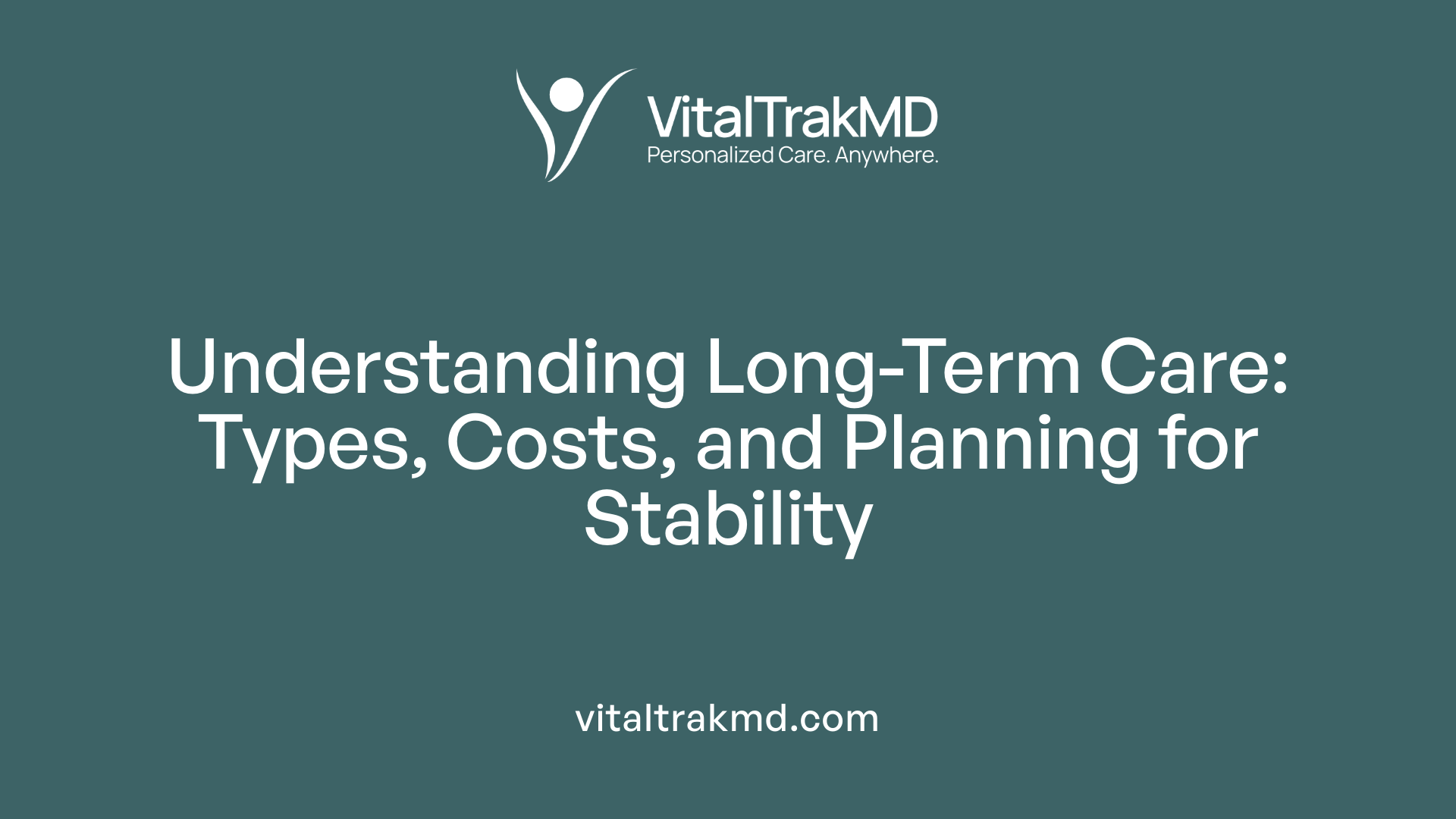Planning a Long-Term Health Strategy for Aging Adults

Understanding the Foundations of Long-Term Care Planning
As populations age worldwide, developing a comprehensive, long-term health strategy for aging adults becomes essential. This involves understanding various care options, costs, legal and financial considerations, and community resources that support healthy aging. Proactive planning not only ensures a better quality of life for older adults but also alleviates the burden on families and healthcare systems.
Overview of Long-Term Care and Its Various Forms

What are the different types of long-term care options and their associated costs?
Long-term care encompasses a variety of living arrangements and support services designed for individuals who can no longer independently perform daily activities such as bathing, dressing, or eating.
Types of Long-Term Care Options:
Skilled Nursing Facilities: These are comprehensive centers offering medical treatment, rehabilitation, and 24-hour nursing care for individuals with serious health issues. The costs in 2024 average around $9,277 per month for a semi-private room, and over $10,600 for a private room.
Assisted Living Communities: These provide help with daily routines like medication management, meals, and mobility in a more independent setting. The median monthly cost is approximately $5,900.
Home Health Care: This includes services like homemaker assistance and home health aides who support with personal care, household chores, and health monitoring. Monthly costs typically range from $6,300 to $6,500.
Adult Day Care Programs: Offering social interaction, supervision, and health-related services during daytime hours, these are more affordable options suitable for seniors wishing to stay at home but needing structured support.
Cost Overview:
| Care Type | Average Monthly Cost | Additional Details |
|---|---|---|
| Assisted Living | $5,900 | Varies based on location and level of care |
| Nursing Home (semi-private) | $9,277 | Includes medical care and personal assistance |
| Nursing Home (private) | Over $10,600 | Offers more privacy and space |
| Home Health Care | $6,300 - $6,500 | For in-home personal and medical support |
Costs for long-term care services tend to rise annually by 5-10%, driven by inflation and evolving standards of care.
Paying for Long-Term Care:
Most individuals pay out-of-pocket, although government programs like Medicaid, which covers many nursing home costs for eligible individuals, play a significant role. Medicare typically does not cover long-term custodial care but may cover short-term skilled nursing or rehabilitation services. Private insurance, including long-term care policies, can help manage expenses, and some also consider hybrid products that combine life insurance and long-term care benefits.
Understanding these options and costs early on allows individuals and families to plan effectively, ensuring access to appropriate care when needed and financial stability amidst rising service expenses.
Developing a Personal and Holistic Care Plan
Strategies for comprehensive care planning
Creating an effective long-term care plan involves multiple steps to ensure all aspects of an individual's health, legal, and personal needs are addressed. It begins with detailed assessments of current health status, mobility, mental wellness, and social connections. Addressing health concerns such as diabetes or heart disease allows for proactive management.
Legal preparations include establishing documents like a durable power of attorney, healthcare proxy, and living will, which clarify personal wishes and authorize trusted individuals to make decisions if necessary. Financial planning involves exploring options such as personal savings, long-term care insurance, government programs like Medicaid, and potentially reverse mortgages.
Community involvement is vital. Connecting with local services such as senior centers, home health agencies, and adult day care centers can provide ongoing support. Planning for aging in place involves home modifications for safety, arranging transportation, and identifying community resources that facilitate independence.
Building a support network of family, friends, and professional caregivers helps create a comprehensive care environment tailored to individual preferences.
Importance of assessments and regular updates
Continuous evaluation of health and circumstances is critical. Regular check-ups with healthcare providers help monitor and adjust medical care plans. Periodic reviews of legal documents ensure they reflect current wishes and life situations.
Keeping the care plan flexible allows adjustments as health conditions change or new needs arise. This includes updating legal documents, revisiting financial arrangements, and reassessing support networks.
Incorporating feedback from the individual and loved ones fosters a person-centered approach, ensuring the plan remains aligned with personal goals and preferences. Ultimately, a well-maintained, holistic plan promotes safety, independence, and dignity in aging.
Legal and Financial Considerations in Long-Term Care

What legal and financial considerations should be addressed in long-term care planning?
Planning for long-term care involves important legal and financial steps to ensure that individuals' preferences are honored and their assets are protected. Legal considerations primarily include establishing documents such as durable powers of attorney for medical and financial decisions, healthcare directives, and living wills. These legal tools allow loved ones or appointed agents to make decisions if the individual becomes unable to do so.
Financial planning is equally vital. It involves evaluating various funding options to cover the costs of different care settings—from in-home services to nursing facilities. Personal savings, long-term care insurance policies (including hybrid plans combining life insurance and care coverage), and government programs like Medicaid and Medicare are fundamental resources. Additional financial vehicles such as reverse mortgages or annuities can also be considered.
Creating an estate plan, including wills and trusts, helps in the smooth transfer of assets and minimizes legal complications for family members. Regularly reviewing legal documents ensures they reflect current wishes and circumstances. Consulting with professionals like elder law attorneys, financial planners, and estate planning experts can help navigate eligibility rules, maximize benefits, and resolve potential disputes.
Proactive legal and financial planning is essential not only to secure adequate care but also to safeguard assets and provide peace of mind for individuals and their families. Making these arrangements early enables individuals to make informed decisions, reduce stress, and avoid financially burdensome surprises later in life.
For further guidance, searching terms like 'Legal and financial planning for long-term care' can provide additional resources and expert advice.
Supporting Aging in Place
What strategies can support aging in place safely and comfortably?
Supporting aging in place successfully requires careful planning and proactive measures. First, assessing and making modifications to the home environment can greatly reduce safety risks. Simple upgrades such as installing grab bars in bathrooms, adding non-slip mats, improving lighting, and removing tripping hazards help prevent falls and accidents.
Creating an accessible living space is essential. This includes wider doorways, ramps for easier entry, and lever-style door handles or faucets. These modifications ensure that older adults can navigate their homes comfortably and safely.
In addition to physical changes, arranging supportive services enhances independence. Personal care assistance, healthcare management, transportation, and meal delivery services enable seniors to manage daily activities with greater ease.
Building a support network is crucial. Family members, friends, community programs, and volunteers can provide emotional support, companionship, and physical assistance. Technologies such as medical alert systems, home monitoring devices, and communication tools also serve to reduce feelings of isolation and enable quick responses during emergencies.
Financial planning plays a pivotal role. Options such as government aid programs, private funding, and insurance should be considered early to fund safety improvements and ongoing support.
Lastly, regular reviews of the living situation allow adjustments as needs evolve. Exploring alternative housing options like senior apartments or continuing care retirement communities can be essential if safety or health priorities change.
Combining home modifications, community resources, support networks, and financial strategies creates an environment where seniors can age comfortably and safely in their own homes.
Family and Caregiver Planning Strategies

What are effective ways for families and caregivers to plan for long-term care needs?
Planning for long-term care is a vital process that ensures aging individuals receive appropriate support as their needs evolve. An effective approach begins with early assessment of the individual’s health, lifestyle, and personal preferences. Families should have open conversations about future care wishes, including whether they prefer aging in place or considering alternative living arrangements like assisted living or nursing homes.
Identifying and exploring various resources and funding options early on is also crucial. These include reviewing personal savings, investigating long-term care insurance policies, and understanding eligibility for government programs such as Medicaid and Medicare. Legal preparations like establishing a durable power of attorney, healthcare proxy, and living will help safeguard personal wishes and ease future decision-making.
Engaging healthcare providers and legal professionals can provide personalized advice tailored to specific health situations and legal considerations. Also, incorporating ongoing communication among family members ensures everyone is informed and prepared for upcoming decisions.
In addition to financial and legal planning, leveraging community resources enhances care quality and caregiver support. Respite services, caregiver support groups, and local aging organizations are valuable for maintaining caregiver well-being and preventing burnout.
Proactive planning isn’t just about making immediate arrangements; it’s an ongoing process that adapts to changing health conditions and personal circumstances. Staying informed, fostering open dialogue, and utilizing available community and professional resources help create a comprehensive, flexible plan that prioritizes dignity, independence, and safety for aging loved ones.
Resources and Support Systems
Families and caregivers can access numerous support networks and tools designed to assist in long-term care planning. Organizations like The Senior Alliance provide tools such as Caregiver Binders and guides to facilitate decision-making. Government programs such as Eldercare Locator offer access to local services and resources.
Community-based programs including adult day care centers, volunteer visitor services, and respite care support not only benefit aging adults but also provide essential relief for caregivers. Additionally, legal practitioners specializing in elder law can assist with estate planning and legal documentation.
Overall, early planning, informed decisions, and utilizing a wide range of support systems lay a strong foundation for effective long-term care. This proactive approach helps ensure that both caregivers and recipients navigate the aging process with confidence, respect, and peace of mind.
Community and Policy Initiatives Promoting Healthy Aging
How can healthy aging be promoted through community and policy initiatives?
Healthy aging can be significantly advanced through strategic community programs and comprehensive policy initiatives. These efforts aim to foster environments that support social engagement, accessibility, and health equity among older adults.
At the national and international levels, organizations such as the U.S. Office of Disease Prevention and Health Promotion (ODPHP) and the World Health Organization (WHO) emphasize the importance of creating age-friendly communities. Policies like the U.S. Healthy People 2030 and the UN Decade of Healthy Ageing focus on establishing coordinated services that cater to the diverse needs of aging populations.
Community-based efforts include evidence-based health promotion activities, chronic disease management programs, and fall prevention strategies. These initiatives help maintain independence and prevent health deterioration.
Local efforts to develop age-friendly cities aim to remove physical and social barriers, reduce ageism, and promote the participation of older adults in community life. This can include improving transportation infrastructure, accessible public spaces, and social inclusion programs.
A collaborative approach involving government agencies, healthcare providers, community organizations, and elderly individuals themselves is crucial. Such partnerships ensure that policies are inclusive, culturally sensitive, and effectively address the barriers faced by older adults.
Overall, fostering supportive environments and implementing inclusive policies are vital steps towards enabling healthier, more independent aging for all community members.
Additional Resources
| Search Query | Focus Areas | Relevant Organizations | Examples of Initiatives |
|---|---|---|---|
| Community strategies for healthy aging | Community programs, policy development | WHO, CDC, AARP | Age-friendly cities, community health programs, intergenerational activities |
Housing and Living Arrangements for Older Adults

What are common living arrangements and housing options for older adults?
Older adults have a variety of housing options to suit their needs and preferences as they age. One popular choice is independent living communities, where seniors reside in apartments or cottages designed for comfort and accessibility, often with minimal support required.
For those who need assistance with daily routines, assisted living facilities offer personalized help, such as help with bathing, dressing, and medication management, along with social activities to promote community engagement.
Individuals requiring more intensive medical care and supervision typically consider nursing homes or skilled nursing centers. These facilities provide around-the-clock healthcare services and specialized support, especially for residents with chronic conditions or mobility challenges.
Continuing Care Retirement Communities (CCRCs) are another comprehensive option. They bring together multiple levels of care—independent living, assisted living, and skilled nursing—within one campus. This setup allows residents to transition smoothly between care levels as their needs change.
Some older adults choose accessory dwelling units (ADUs)—small, self-contained living spaces built on family properties. ADUs enable seniors to maintain independence while staying close to loved ones.
Additional living arrangements include age-restricted or senior apartments, cohousing communities, house-sharing setups, and community-based models like villages, encouraging social interaction, affordability, and mutual support.
Choosing the right housing depends on health status, personal preferences, and available support, but all these options aim to help older adults age comfortably and safely in the environment they prefer.
Impact of Social Determinants and Global Aging Trends

How do social determinants of health impact aging populations, and what can be done to address them?
Social factors such as economic stability, social support, neighborhood quality, and healthcare access significantly influence how well older adults age. These social determinants can affect their ability to manage chronic illnesses, maintain mobility, and stay socially connected.
For example, limited income or housing instability can lead to increased risks of disability and mental health challenges. Older adults living in unsafe neighborhoods or lacking transportation options may experience social isolation, which can worsen health outcomes.
To improve aging experiences, strategies include enhancing healthcare accessibility, creating age-friendly communities, and fostering opportunities for social engagement. Education tailored to seniors, policy reforms, and community-based programs all play roles in mitigating disparities.
Internationally, many nations are adopting comprehensive aging policies aligned with frameworks like the Madrid International Plan of Action on Ageing (MIPAA) and the UN Decade of Healthy Aging. These plans emphasize the importance of inclusivity, social protection, and community participation.
Key approaches include community involvement, ensuring equitable resource distribution, and promoting environments that support health and dignity. By addressing social determinants head-on, societies can support healthier, more connected, and more independent aging populations.
Building a Society for Aging with Dignity and Support
In conclusion, effective long-term health strategies for aging adults require a multi-faceted approach that encompasses diverse care options, legal and financial planning, community engagement, and policy support. Early, comprehensive planning and proactive risk management can greatly enhance quality of life and independence in later years. As nations and communities align their efforts with international frameworks, fostering social inclusion, health equity, and age-friendly environments becomes paramount. Together, these strategies lay the foundation for a society where aging with dignity, safety, and well-being is a shared priority.
References
- What Is Long-Term Care? | National Institute on Aging
- A Caregiver's Guide to Long-Term Care Planning
- Master Plan for Aging
- Aging in Place: Growing Older at Home
- Guide to Planning for Aging Seniors by the NCPC
- Caregiver Resources & Long-Term Care - HHS.gov
- How To Plan for Long-Term Care When You're Aging Alone
- Developing a Multisector Plan for Aging
- Long-Term Care: Are Older Adults Ready? | National Poll on ...
- How to Plan for Long-term Care | SALMON Health and Retirement
Recent articles
Want to Feel Better and Live Healthier?
Join hundreds of patients taking control of their health with personalized care that fits their life – not the other way around.
Rated 4.8/5 by 32+ customers







